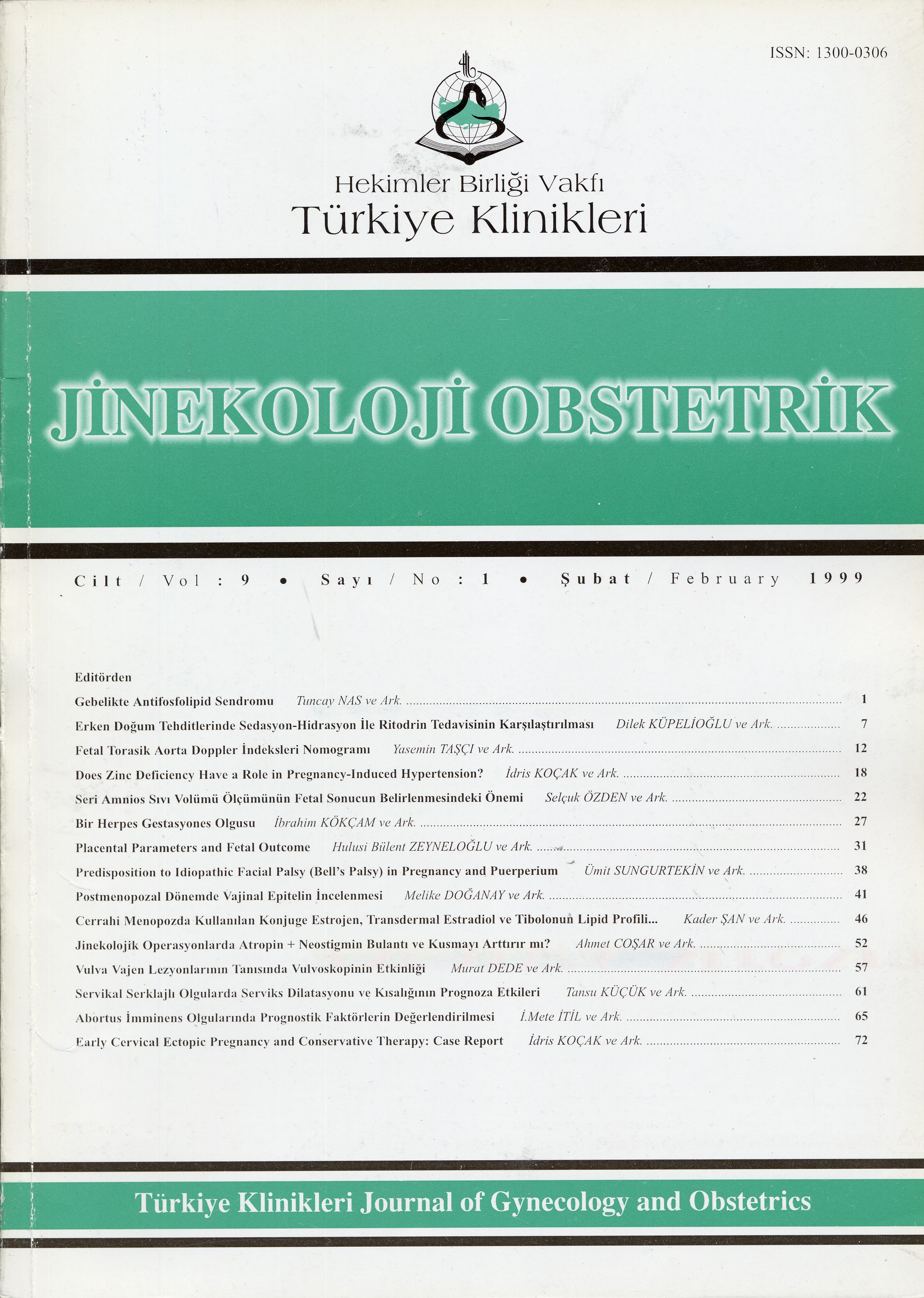Open Access
Peer Reviewed
ARTICLES
3772 Viewed1278 Downloaded
Clinical Significance Of The Serial Measurements Of Amniotic Fluid Volume In The Prediction Of Fetaloutcome In The Postdate Pregnancies
Postterm Gebelerde Seri Amnios Sıvı Volümü Ölçümünün Fetal Sonucun Belirlenmesindeki Klinik Önemi
Turkiye Klinikleri J Gynecol Obst. 1999;9(1):22-6
Article Language: TR
Copyright Ⓒ 2025 by Türkiye Klinikleri. This is an open access article under the CC BY-NC-ND license (http://creativecommons.org/licenses/by-nc-nd/4.0/)
ÖZET
Amaç: Postterm gebelerde izlem dönemi içindeki amniotik sıvı volümü değişimi ile fetal-neonatal sonuçlar arasındaki ilişkiyi belirlemek. Çalışmanın yapıldığı yer: Zeynep Kamil Kadın ve Çocuk Hastalıkları Hastanesi, İstanbul. Materyal ve metod: Prospektif olarak 147 postterm gebelik olgusu üzerinde çalışıldı. Seri amniotik sıvı indeksi ölçümleri ile hastalar izlendi. Amniotik sıvı indeksi değişim miktarı ile fetal-neonatal sonuç arasındaki ilişki araştırıldı. Bulgular: Amniotik sıvı indeksi <5 cm olan olgularda nonreaktif NST, mekonyum pasajı ve fetal distrese bağlı sezaryen seksiyo uygulanma oranı anlamlı olarak yüksek bulundu (sırası ile p=0.0001, p=0.0001, p=0.0004). Bu olgularda 1 ve 5 dakika Apgar skorları anlamlı olarak düşük ve neonatal yoğun bakım gereksinim oranı anlamlı olarak yüksek idi (sırası ile, p=0.001, p=0.003, p=0.0004). Amniotik sıvı indeksinin <5 cm olmasının fetal distrese bağlı sezaryeni predikte etmedeki sensitivite, spesifite, pozitif prediktif ve negatif prediktif değerleri sırası ile %75.0, %60.3, %65.7, %10.2 olarak saptandı. Sonuç: Seri amniotik sıvı indeksi ölçümü postterm gebeliklerin yönetiminde faydalı bir yaklaşımdır.
Amaç: Postterm gebelerde izlem dönemi içindeki amniotik sıvı volümü değişimi ile fetal-neonatal sonuçlar arasındaki ilişkiyi belirlemek. Çalışmanın yapıldığı yer: Zeynep Kamil Kadın ve Çocuk Hastalıkları Hastanesi, İstanbul. Materyal ve metod: Prospektif olarak 147 postterm gebelik olgusu üzerinde çalışıldı. Seri amniotik sıvı indeksi ölçümleri ile hastalar izlendi. Amniotik sıvı indeksi değişim miktarı ile fetal-neonatal sonuç arasındaki ilişki araştırıldı. Bulgular: Amniotik sıvı indeksi <5 cm olan olgularda nonreaktif NST, mekonyum pasajı ve fetal distrese bağlı sezaryen seksiyo uygulanma oranı anlamlı olarak yüksek bulundu (sırası ile p=0.0001, p=0.0001, p=0.0004). Bu olgularda 1 ve 5 dakika Apgar skorları anlamlı olarak düşük ve neonatal yoğun bakım gereksinim oranı anlamlı olarak yüksek idi (sırası ile, p=0.001, p=0.003, p=0.0004). Amniotik sıvı indeksinin <5 cm olmasının fetal distrese bağlı sezaryeni predikte etmedeki sensitivite, spesifite, pozitif prediktif ve negatif prediktif değerleri sırası ile %75.0, %60.3, %65.7, %10.2 olarak saptandı. Sonuç: Seri amniotik sıvı indeksi ölçümü postterm gebeliklerin yönetiminde faydalı bir yaklaşımdır.
ANAHTAR KELİMELER: Amniotik sıvı indeksi; Postterm gebelik
ABSTRACT
Objective: To determine the relationship of the fetal and neonatal outcomes with the variation in amniotic fluid indices during the postterm period. Institution: Zeynep Kamil Women and Children`s Hospital, Istanbul. Study design: 147 postterm pregnant women were followed-up prospectively by serially amniotic fluid index measurements. The relationship of the variation of the amniotic fluid indices with fetal and neonatal outcomes was evaluated. Results: Rates of the passage of meconium during labor, cesarean section for fetal distress were found significantly higher in the group with amniotic fluid index less than 5 cm (p=0.0001, p=0.0001, p=0.0004, respectively). One and 5 minute Apgar scores were significantly lower and need for neonatal intensive care unit was significantly higher in this group as well (p=0.001, p=0.003, p=0.0004, respectively). In the prediction of cesarean section for fetal distress, sensitivity, specificity, positive and negative predictive values of the amniotic fluid index less than 5 cm were calculated as 75.0%, 60.3%, 65.7%, 10.2%, respectively. Conclusion: Serial measurement of amniotic fluid index is a useful approach in the management of the postterm pregnancies.
Objective: To determine the relationship of the fetal and neonatal outcomes with the variation in amniotic fluid indices during the postterm period. Institution: Zeynep Kamil Women and Children`s Hospital, Istanbul. Study design: 147 postterm pregnant women were followed-up prospectively by serially amniotic fluid index measurements. The relationship of the variation of the amniotic fluid indices with fetal and neonatal outcomes was evaluated. Results: Rates of the passage of meconium during labor, cesarean section for fetal distress were found significantly higher in the group with amniotic fluid index less than 5 cm (p=0.0001, p=0.0001, p=0.0004, respectively). One and 5 minute Apgar scores were significantly lower and need for neonatal intensive care unit was significantly higher in this group as well (p=0.001, p=0.003, p=0.0004, respectively). In the prediction of cesarean section for fetal distress, sensitivity, specificity, positive and negative predictive values of the amniotic fluid index less than 5 cm were calculated as 75.0%, 60.3%, 65.7%, 10.2%, respectively. Conclusion: Serial measurement of amniotic fluid index is a useful approach in the management of the postterm pregnancies.
MENU
POPULAR ARTICLES
MOST DOWNLOADED ARTICLES





This journal is licensed under a Creative Commons Attribution-NonCommercial-NoDerivatives 4.0 International License.










